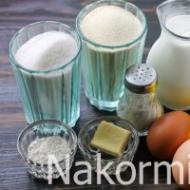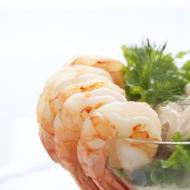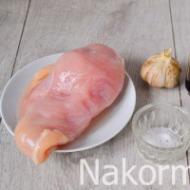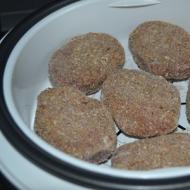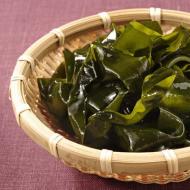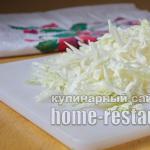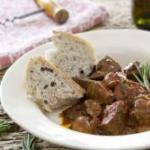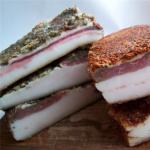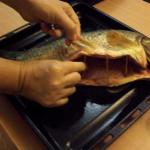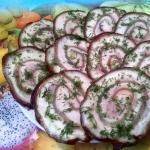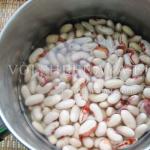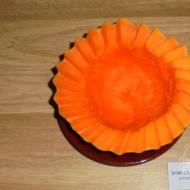
How to make your own horseradish from the root. Khrenovina - nine classic recipes for cooking for the winter. Green horseradish sauce
Preparing horseradish at homeHorseradish is rightfully considered the main seasoning in Russian cuisine. It is served with cold and hot dishes, used in canning and preparing various sauces. In the article you will find recommendations on how to make horseradish at home, the recipe for which can be very varied.
Horseradish grows everywhere in Russia. It can be found not only in the corners of summer cottages, but also in meadows or along river banks. It is quite difficult to find it on supermarket shelves, but in city markets it is not difficult to buy fresh root for sauce or aromatic leaves for marinade.
How horseradish grows, its properties and uses
This perennial plant can be classified as a member of the cabbage family. Horseradish has a powerful branched root system and erect, wide leaves. Horseradish is not picky about soil composition and can grow in both sunny and shaded areas. You can find this plant in almost every summer cottage, since horseradish preparations are to the taste of many.
Gardeners try to set aside a place for this crop in the corner of a plot or near a fence, since horseradish grows quickly and can interfere with other plants.
The aggressive and aggressive growth of horseradish begins when it “goes wild”
This happens due to non-compliance with the rules of agricultural technology, when a crop grows in one place for many years. The fact is that horseradish roots contain numerous buds that grow under any conditions, regardless of their depth. If you do not dig up horseradish every year or two, the roots will go deep to a distance of up to 2 m, and it will be impossible to dig them out.
Remaining in the ground, they will constantly produce new growths, occupying more and more new areas with their growth. Experienced summer residents know that it is much easier to introduce horseradish on your property than to get rid of a “feral” plant.
Horseradish contains many groups of vitamins (C, B, E), as well as folic acid, many macro and microelements useful for the body, essential oils, and phytoncides. Horseradish is used to prevent scurvy, flu, diseases of the genitourinary system, and as an appetite stimulant.
In cooking, horseradish, the recipe for which is discussed below, is famous for its special, pungent smell and pungent taste with a sweetish note.
Harvesting horseradish roots
To make horseradish preparations for the winter, use the root, which contains a large amount of useful substances. They dig it up in late autumn or early spring. It is during this period that the root ripens, its taste becomes sharp without bitterness, or, as they also say, “evil”, “vigorous”. A few bushes can be left in the garden bed and the roots can be dug up as needed.
Horseradish roots dry out very quickly
To avoid this, store them in plastic bags or in a wooden box, the bottom of which is sprinkled with wet sand, in the cellar. If the roots are a little wilted, harvesting horseradish for the winter is possible when their six-hour soaking in ice water is completed.
In summer, horseradish leaves are used for canning cucumbers and tomatoes. They are added as seasonings to the marinade for a rich taste. Pickled and pickled cucumbers with the addition of leaves will always be crispy and aromatic.
Any recipe for preparing horseradish involves first chopping its roots. This is not easy to do, because the pungent smell hits the nose and eyes, tears flow in a stream at the very first attempts to grind the root. Some tricks will help make this process easier:
- Before chopping, place the horseradish root in the freezer for about half an hour.
- If you are grinding horseradish in a meat grinder, put plastic bags over the inlet and outlet openings.
- Open the windows wide and turn on the fan. If you have the opportunity to grate horseradish in the fresh air, even better.
- A mask that covers your nose and eyes will also help avoid exposure to the pungent odor on your mucous membranes.
The best horseradish recipes
Cooking horseradish at home will allow you to stock up on the hot seasoning for the winter. It is served with aspic, jellied meat, jelly, homemade sausages and other dishes.
Horseradish in Russian
For a long time, preparing horseradish according to the classic recipe has been very popular. For horseradish in Russian we will need:
Horseradish root (1 kg) is peeled and washed. Grate it on a fine grater or grind it in a meat grinder. Add salt (1 tbsp), sugar (3 tbsp), and boiling water (1 cup). The ingredients are quickly mixed and placed in sterile jars. Add 2-3 drops of lemon juice to each jar on top. If the jars are sealed with canning lids, horseradish will be stored in the refrigerator for up to 3 months.
This horseradish preparation is served either in its pure form or diluted with sour cream in a ratio of 1 to 1. It is an ideal addition to boiled potatoes, jellied meat, jellied meat, and meat dishes.
Horseradish with beets
Beetroot horseradish is a well-known horseradish recipe that can be easily prepared at home even by inexperienced housewives. The seasoning turns out bright, stimulating the appetite.
- Fresh horseradish root (10 pieces medium size);
- Raw beets (1 pc.);
- Salt and sugar to taste;
- Wine or apple vinegar (5-6 tablespoons).
Horseradish and beets are ground on a grater or in a meat grinder. Add salt and sugar to taste, and at the very end - vinegar. If the seasoning is too thick, you can add cold boiled water to the desired consistency. The seasoning is mixed, placed in jars, tightly closed with lids and placed in the refrigerator. This “evil” seasoning will remain for a month.
If there is no need to store horseradish and beets for a long time, you do not need to add vinegar.
Adjika Khrenoder (horseradish, gorloder)
Cooking horseradish at home, the recipe for which we will now tell you, is popular among lovers of spicy hot sauces.
It is prepared like this:
- 1 kg of tomato is ground in a meat grinder;
- Next, 300 g of horseradish root and garlic are ground into a meat grinder or grater;
- Add 1 tbsp. l. salt and sugar and 2-3 tbsp. wine vinegar, or 1-2 tbsp. l. table vinegar 9%;
- The finished sauce is poured into sterile jars and tightly closed with lids.
Horseradish with apples and carrots
Those who like a milder taste will like the recipe for making horseradish at home with carrots and sour varieties of apples. It is prepared as follows:
- 2 kg of carrots are grated on a fine grater;
- 100 grams are also prepared. garlic;
- 100 gr. apples (Antonovka, Semerenko) cut into thin slices;
- Place apples, carrots, horseradish in layers in a jar and fill with marinade.
The marinade is prepared like this:
- Boil 1 liter of water with 3 tbsp. sugar and 1 tbsp. salt. At the end add 2 tbsp. vinegar 9%;
- Sterilize prepared jars with salad for 15-20 minutes and roll up.
Bottom line
It is not difficult to prepare horseradish at home, but you need to remember that when crushed, its smell irritates the mucous membranes and causes tearing. The finished seasoning will be a worthy addition to your culinary masterpieces and will protect against colds in the winter.
Horseradish is a very valuable vegetable. The root of this plant has a pungent odor and a sweetish taste, which later becomes pungent and pungent. When grated, mixed with vinegar, it becomes an excellent seasoning for a variety of dishes. Its pungent taste is due to the presence of the glycoside sinigrin, which is broken down under the influence of the enzyme myrosin, forming sulfur-potassium salt, sugar and essential oils. It is allyl oil that affects the mucous membranes, causing burning and lacrimation. Before we look at how to cook horseradish at home, let's get acquainted with its beneficial properties.
Beneficial features
Horseradish is an excellent remedy against scurvy because it contains a large amount of vitamin C. Since ancient times, this plant has been used to treat various diseases, including tumors. In general, homemade horseradish is a storehouse of useful substances; it contains many vitamins, essential oils, phytoncides, resinous substances, fiber, as well as macro- and microelements. That is why this product has a powerful healing effect on the human body, stimulates the functioning of all internal organs and prevents the occurrence of diseases.
Now that we know about this healing plant, let's take a closer look at how to prepare horseradish at home.
Russian table horseradish
To prepare such a dish, first peel the root with a knife and rinse it. Then they grate it. Cold boiled water is poured into the bottom of clean glass jars and the grated root is laid out in layers so that it does not have time to dry in the open air. Add a little water to the resulting mass until a thick paste forms, one piece of sugar or honey and salt to taste. You can also add juice and grated lemon zest, in which case the amount of water will need to be reduced.

We continue preparing horseradish at home. So, the remaining pieces of root are placed in a bowl with the grated product and mixed so that they end up at the bottom. It should be noted that the finished horseradish should have a thick consistency, not watery. Before serving the appetizer, each tablespoon is diluted with a dessert spoon of sour cream. This dish must be eaten within twelve hours, otherwise it will lose all its nutritional properties.
Horseradish pickled
Ingredients: one kilogram of horseradish root, half a liter of water, forty grams of sugar, twenty grams of salt, fifty grams of vinegar (9%), cinnamon and cloves to taste.
Preparation
The roots must be washed, peeled and grated, or passed through a meat grinder. The mass is placed in dry, sterile half-liter jars. Then add sugar and salt to the water, bring to a boil, add spices, cover with a lid and leave until the mixture has cooled to fifty degrees Celsius. After this, vinegar is added and left for a day. After time, the solution is filtered, poured into jars and rolled up.

Horseradish with tomatoes
Let's look at how to cook horseradish at home with tomatoes.
Ingredients: two hundred and fifty grams of horseradish root, three kilograms of tomatoes, two hundred grams of garlic, three tablespoons each of salt and sugar.
Preparation
The roots are well cleaned and soaked for half an hour in cold water. After time, put it in a blender and grind. The tomatoes are washed, cut into slices and minced in a meat grinder along with peeled garlic. All ingredients are placed in a blender, salt and sugar are added, and then ground. The horseradish appetizer is ready. It can be put in jars and stored in a cold place for a long time, but if consumed immediately after preparation, the body will receive all the nutrients from it. Numerous studies have shown that the pureed product retains all vitamins for one week, so it is recommended to prepare the seasoning in such quantities that you can eat it during this time.
Hrenoder
This appetizer is spicy, it has an unusual taste and goes well with fried and stewed meat, jellied meat, fish, dumplings and other dishes. Let's look at how to cook horseradish at home using this recipe.

Ingredients: one kilogram of horseradish root, five hundred grams of beet juice, one hundred grams of granulated sugar, one glass of table vinegar, thirty grams of salt.
Preparation
The root is cleaned, washed and twisted through a meat grinder. Raw beets are peeled, grated, and the juice is squeezed out of the resulting mass, which is then filtered through cheesecloth or a sieve. Granulated sugar and salt are poured into it, mixed thoroughly, vinegar and horseradish are added. The resulting horseradish is placed in sterile jars and covered with nylon lids, after which it is put away in a cold place. This recipe for homemade horseradish is very simple, and the end result is a quite healthy dish that can be served with meat and fish.
Apple horseradish
Ingredients: three hundred grams of sour apples, fifty grams of sugar or honey, one hundred grams of grated horseradish root, salt and lemon juice to taste.
Preparation
The apples are washed and coarsely chopped without removing seeds and peel. Then they are sprinkled with sugar or honey and stewed. While hot, they are rubbed through a sieve, mixed with horseradish, salted and sprinkled with lemon juice. The snack is ready!

What do you eat horseradish with?
We already know how to cook horseradish at home, let’s look at what dishes it is used with.
So, this healthy product is served with all fish dishes, such as jellied fish, pies, calf, smoked stellate sturgeon, boiled sturgeon, and so on. At the same time, horseradish is consumed with cold meat dishes, especially pork. So, it is served with jelly, jellied meat, jellied pig, jellied poultry, boiled cold beef, tongue, pork head and others.
In Russian cuisine, horseradish was prepared immediately before serving, trying not to leave it for more than two days. At the same time, it was piquantly spicy, made without vinegar. Today, this seasoning is quite popular in kitchens all over the world; it has a delicate soft taste along with an unexpected piquancy, which is the biggest charm of the snack.
A few simple secrets
Knowing how to prepare horseradish at home, you must not forget about some recommendations, following which will help you get a real “Russian appetizer.” So, according to the old Russian recipe, vinegar is not added to horseradish, so it must be prepared immediately before use (the shelf life in this case does not exceed four hours).

In order for the snack to be sweet, but “evil”, you need to choose high-quality products for its preparation. In this case, the horseradish root should be as thick as a finger, without any damage, strong and juicy. Even if the damage can be corrected by removing it mechanically, cutting out bad places, the loss of juiciness is irreparable. Soaking the root leads to the leaching of juices, which give the dish aroma and piquant pungency.
How to properly store horseradish?
Properly preserved plant root does not lose its beneficial properties; a snack made from it will turn out to be “real.” To do this, it is kept in boxes with sand, laid in rows so that one root does not touch another. All rows are covered with clean sand without impurities. Once a week, each box is watered (sprinkled) with water so that the sand always remains moist. If you do everything correctly, you can get fresh, juicy horseradish throughout the year.
A little history
In the recipes of ancient Russian cuisine, horseradish was used as a seasoning for fish back in the sixteenth century. A little later, it was introduced into kalya, pickles, solyankas, and gravies a few minutes before serving. With the invention of salads, horseradish began to be introduced into them. Thus, it was added to dishes made from carrots, beets, radishes and apples, rutabaga, boiled root vegetables, as well as to vinaigrettes.

Until the beginning of the nineteenth century, the seasoning from this vegetable was dominant; it had not only nutritional value, but also preventive, since horseradish helped prevent the development of various infectious and bacteriological diseases. Later, horseradish began to be replaced with mustard, but Russian cuisine only lost out here. Today, the seasoning from this plant is indispensable on any table, since its taste is so unique and attractive that not everyone is able to resist. Moreover, this plant, being a natural antibiotic, is capable of defeating many ailments, which is so important in our time. You just need to remember that the dish can retain its beneficial properties for a short period of time, so it needs to be cooked before serving.
Horseradish is an indispensable component of home canning, because the roots and leaves of this plant give pickled vegetables a piquant and spicy taste. But experienced housewives also prepare horseradish itself, making it into a spicy seasoning. Appetizing horseradish preparations for the winter will not only be an excellent addition to fish and meat dishes, but will also strengthen the immune system, which is especially important in the cold season.
Horseradish is an indispensable component of home canning.
Horseradish roots can be preserved either separately or with the addition of various ingredients, for example, lemon, beets, apples or garlic. Recipes for horseradish sauces with various vegetables are called golden and for good reason, because they have a wonderful taste and exquisite aroma, and they can even be used as a salad dressing.
Cooking horseradish without additives for the winter
The classic recipe for preparing this useful plant does not take much time and is very simple and easy to prepare.
What you will need:
- fresh horseradish roots – 1 kg;
- plain water - one glass;
- vinegar solution – 150 ml;
- salt – 30 g;
- sugar – 30 g.
 The classic recipe for preparing this useful plant does not take much time.
The classic recipe for preparing this useful plant does not take much time. How to cook:
- Peel the roots and cut each one into two or three parts. Pour the raw material with ice water for half an hour. This method will make the root vegetables more juicy and will help you process them effortlessly.
- The next step is chopping the horseradish. For this purpose, you can use a meat grinder, fine grater or blender.
- To make the marinade, combine sugar and salt with water, bring to a boil and at the very end carefully pour in the vinegar solution.
- Cool the brine, mix with grated horseradish, place this mass in sterile glass containers and close with lids.
Vinegar and citric acid successfully replace each other, so you can safely add it to a preparation of horseradish root vegetables instead of a vinegar solution.
Horseradish for the winter in a jar without sterilization
This is a quick and easy way to preserve horseradish root vegetables for the winter. This recipe does not use vinegar, so this preparation is considered healthier.
Ready-made horseradish can be purchased today in any store. But it’s still much better to prepare this spicy seasoning yourself, and it’s quite easy to do. The following recipes for preparing table horseradish will not take much of your time and effort, and as a result you will get a very tasty addition to a wide variety of dishes.
Table horseradish – taste with benefit
The main benefit of table horseradish lies in the essential oils that are part of the root. They exhibit a powerful antiseptic effect, thanks to which the body receives reliable protection against viruses and pathogenic bacteria. This property makes horseradish a natural antibiotic. In addition, by consuming this seasoning in small quantities, you can increase your appetite and stimulate your intestines.
The horseradish root contains vitamins of group B, as well as PP and C. Moreover, it contains approximately 4-4.5 times more of the latter than in many citrus fruits. This product is also rich in microelements, including sulfur, potassium, iron and phosphorus.
Freshly prepared table horseradish, which is no more than seven days old, has the greatest benefit. After this time, the beneficial substances are gradually destroyed and horseradish becomes just a spicy seasoning. For this reason, no store-bought product can compare with homemade sauce.
Important! However, remember that table horseradish will not be useful for everyone. It should be used with caution in acute diseases of the digestive system and diseases that are accompanied by high acidity!
In order for table horseradish to turn out tasty, and the process of its preparation to be extremely simple and enjoyable, you must adhere to several important rules.
- The essential substances that the root is rich in can cause severe lacrimation and irritation on the skin. To prevent this from happening, it is better to work with gloves, and grind the roots themselves not on a grater, but pass them through a meat grinder, after placing a plastic bag over the outlet hole.
On a note! To make horseradish less aggressive, it should be placed in the freezer a couple of hours before processing!
- The most suitable roots for preparing table horseradish are the roots of the autumn harvest, which were dug up in September and are 30-40 cm long.
- If the roots that you prepared for seasoning have dried out somewhat, then plain water will help bring them back to “life.” Just soak the product and after 3-4 days it will be completely ready for use.
- After a month of storage, table horseradish loses its burning qualities, so lovers of strong seasonings will no longer be interested in such a product. Of course, you can prepare a new portion every month, but we recommend doing it easier - closing the seasoning for the winter by sealing it in sterilized jars. Some recipes allow you to store it from 4 months to a year, right in the pantry.
Let's find out how to make table horseradish.
Horseradish - a classic recipe
For the recipe we take:
- kilo of roots;
- a quarter liter of water;
- tables. a spoonful of salt;
- a couple of tables. spoons of sugar;
- tables. a spoonful of lemon juice.
We clean the prepared roots and pass them through a meat grinder with a fine grid. The result should be a puree with a fine, delicate consistency. To prevent horseradish from irritating your eyes, we attach a plastic bag to the outlet hole. Transfer the finished mass to a large bowl, add the specified amount of sugar and salt.
Pour water into a saucepan, bring it to a boil and pour in the processed roots. Mix thoroughly, pour ¾ teaspoon of freshly squeezed lemon juice into small sterilized jars - it will act as a preservative and will not allow the mass to darken.
On a note! It is better to use small jars; you do not need to add a lot of juice - otherwise the finished seasoning will be too sour.
We immediately seal the jars and send them for storage. Table horseradish prepared according to this recipe will retain its taste for three to four months.
With beet juice
For the recipe we take:
- half a kilo of horseradish;
- 0.2 liters of water;
- 0.2 liters of vinegar;
- tables. a spoonful of sugar;
- tables. a spoonful of salt;
- a quarter glass of beet juice.
Wash the roots thoroughly, fill with water, and leave in the refrigerator overnight. In the morning, we clean the products and cut them into arbitrary pieces. Place a grid with small holes in a meat grinder and grind the horseradish. Pour boiling water over the resulting mass, add sugar, salt and mix.
Wash and peel the beets, grate them on a fine grater and squeeze out the juice. Measure out 2.5 tablespoons and combine with the specified amount of vinegar. Add this to the horseradish and mix.
Distribute the seasoning into sterilized jars, seal tightly and store in the refrigerator. Table horseradish prepared according to this recipe can be stored for a year.
With garlic and tomatoes
For the recipe you need to take:
- kilo of horseradish;
- kilo of tomatoes;
- three cloves of garlic;
- a couple of tables. spoons of sugar;
- tables. spoon of salt.
Pour some water into the saucepan and bring it to a boil. Blanch the tomatoes for 30 seconds, then remove the peel and cut into four parts. Soak the roots in water for 24 hours, peel and cut into small pieces. Remove the husks from the garlic and chop it.
We prepare the meat grinder: install a fine grate and attach a plastic bag to the outlet hole. Grind the horseradish and tomatoes, turning them one by one. Add crushed garlic, sugar, salt to the resulting mass and mix well. Place the seasoning in dry, sterilized jars, roll up the lids and store.
Table horseradish prepared according to this recipe can be stored for 9 months.
Bon appetit!
All materials on the website are presented for informational purposes only. Before using any product, consultation with a doctor is MANDATORY!
HORSERADISH
Horseradish roots contain up to 150-250 mg of vitamin C (five times more than in lemons and oranges), up to 7 percent carbohydrates, essential oils, mineral salts, and phytoncides. They are eaten as a spicy seasoning for cold dishes, salads, as well as fish and meat products.
Horseradish roots are grated on a fine grater, seasoned with salt, sugar (and vinegar in some non-Russian cuisines - see below for adding vinegar to horseradish seasoning). Thanks to the essential oil content, horseradish in small doses increases appetite and improves intestinal activity.
To store the dug horseradish roots, you need to free them from the ground and cut off the tops and shoots 1-1.5 cm above the root.
Russian table horseradish
Horseradish should be considered the main Russian cold seasoning, used for all cold and boiled types of fish dishes (jellied, whole, boiled whole fish, hot smoked red fish (stellate sturgeon), boiled sturgeon), as well as for fish pies and kulebyaks, which were also accepted eat horseradish, if they were consumed cold, the next day, and not in the heat of the day.
Along with fish dishes, horseradish seasoning was also served with cold meat dishes, especially pork. Thus, horseradish was necessarily used for jelly, jellied meat, cold jellied pig, poultry jellied meat, boiled beef (cold), tongue, beef and pork offal (but not lamb!), and pork head (on Vasiliev day, January 7 - 10), to jellied and cold veal, and later, at the end of the 19th century, to cold roast beef, although this dish was English and, strictly speaking, should have been eaten with mustard.
In Russian classical cuisine, horseradish was always prepared only directly for the table. and they tried not to leave it for more than one or two days, since it was believed that horseradish should be peculiarly piquant and spicy, and if left for more than two days after cooking, it would lose its potency. In addition, in Russian, horseradish was always prepared without vinegar, which “kills” the power of horseradish and gives it its own taste and acetic-sour pungency, which is not characteristic of national Russian dishes.
Vinegar-based horseradish, or the so-called “Polish horseradish” prepared in Belarus, Volyn (Ukraine) and mainly in Lithuania.
It was from there that the preparation of horseradish on a vinegar base came from for the undemanding, often drunken consumer (who “would like a sour nose”), designed for two-week and sometimes even monthly storage and long-term transportation. This type of horseradish seasoning does not give dishes a specific sweet “Russian taste”, but with the disappearance of home cooking, it began to increasingly replace the traditional Russian horseradish seasoning, the characteristic feature of which was an unusually soft, delicate taste along with an extremely strong and unexpected piquancy that makes up the greatest charm of this Russian seasoning. Only such horseradish played its traditional role in the national feast: on the one hand, a purely culinary role - it made the dishes especially attractive in Russian, and on the other hand, a specifically table, entertaining role, since it always gave rise to jokes and fun at the table, to ironic remarks about newcomers or clumsy, unsubtle, inept people (all sorts of rootless aliens) who did not understand and did not master the art of using horseradish as a seasoning, did not grasp what the secret of this use was.
Meanwhile, this secret was extremely simple: it was necessary to eat horseradish only after biting off and only slightly chewing (but not swallowing!) another piece of fish or meat. In such cases, some “dodgy” people, with a certain dexterity, could consume relatively large portions of horseradish quite safely, while their less experienced and inept diners sometimes jumped up in their seats and burst into tears (to the deafening laughter of all those present) from the most insignificant, even tiny doses consumed without knowledge of specifics and traditions. Such people were always recognized as newcomers who did not have their own home and strong Russian family roots. Hence one of the old Russian customs of testing the bride and groom, which consisted of treating them to dishes in which the use of horseradish was obligatory. At the same time, the incompetent often received a complete refusal, even if he had other positive qualities.
First of all, for horseradish to be “sweet and evil”, you need a good, high-quality starting product. This means that the horseradish root must be at least as thick as a finger, without damage, juicy, and strong. External damage can be eliminated purely mechanically by cutting out rotten, ulcerated and bruised, cut and contaminated areas. The loss of juiciness by the horseradish root is a defect that is practically incorrigible, because an attempt to soak the horseradish, although it can lead to the restoration of its mechanical elasticity and thereby make it easier to grate, will inevitably lead to leaching and soaking of the juices that give the horseradish root its aroma , and its amazing peculiar piquant “causticity” (in Russian - “anger”). The degree of this leaching may be different in each case, but it always affects not only the strength of the finished table horseradish, but also the duration of preservation of this strength in the finished seasoning. As a rule, the strength of soaked horseradish does not remain strong for more than a day, and this explains the introduction of “strength” imitators such as vinegar into ready-made table horseradish.
Russian table horseradish should be prepared only from high-quality raw materials - as all dishes of Russian cuisine should be prepared. To do this, it is necessary to properly preserve the root after digging in the fall or spring. Horseradish is stored in a box with sand, laying it in rows so that one root never touches another, and filling each row with clean, sifted sand, free from clay and earth impurities. Once a week, this box of sand should be slightly watered (sprinkled) with water so that the sand is always evenly slightly damp. This way you can have absolutely fresh, juicy horseradish all year round.
- How to properly prepare RUSSIAN TABLE HORSERADISH:
1. When preparing table horseradish, peel the root with a knife, but avoid washing it by rinsing it, at least after cleaning it under cold running water.
2. Then rub it on a fine grater, having previously prepared a jar (glass, porcelain) with cold boiled water poured onto its bottom. As the horseradish is grated, the grated portions are constantly placed in this bowl, not allowing them to dry out in the open air.
3. Then, when the grating process is over, add a little more water to the grated mass until it has the consistency of a thick porridge, then sweeten with 1 piece of sugar and salt to taste (a pinch of salt).
It is good to additionally add grated lemon zest and lemon juice, reducing the amount of water accordingly.
The pieces of root remaining during grating are also placed in a bowl with the prepared horseradish, turning them with a spoon so that they are at the bottom.
This preparation of table horseradish should not be watery, but rather thick, with the consistency of a viscous porridge.
4. Before serving, each tablespoon of this preparation is diluted with a dessert spoon of sour cream.
It is this composition that is called “Russian table horseradish” (but for no more than 8-12 hours).
Russian table horseradish is one of the best seasonings in world cooking. Only absolute instability in storage (no more than 12-16 hours) does not allow it to become one of the most common seasonings, along with mustard, mayonnaise, ketchup and soy sauce. Freshness and the absence of vinegar distinguishes Russian table horseradish from horseradish seasonings used in the Baltics or Transcaucasia and including vinegar.
Only on the second or third day, if the prepared horseradish begins to show a decrease in pungency, you can add a little 0.5 percent vinegar to it, but this will no longer be Russian horseradish, but a so-so “horseradish” (a product spoiled by storage).
In Transcaucasia, a stronger 1.5% solution of real homemade wine vinegar is added and, in addition, such horseradish is tinted with beet juice. This type of horseradish seasoning is used with the Georgian jellied piglet - muzhuzhi, while the Russian type of horseradish seasoning is intended for veal or beef jellied meat, for jellied poultry and, mainly, for dishes from jellied, boiled and hot-smoked fish . It is in these cases that vinegar as a base, which coarsens the horseradish seasoning, and thereby the tender fish meat, is completely unsuitable, while sour cream acts both as a contrast and as an ennobler.
In classical Russian cuisine, horseradish is used not only as a seasoning for a cold appetizer table. This use mainly became established only in the 18th century and especially in the 19th century, when the snack table began to play a significant role in public and official life and when, due to the expansion of the network of taverns and the spread of vodka, it began to invade more and more into home life. It was in this situation that not the culinary, but the functional and auxiliary role of horseradish increased as a seasoning, acting as a moderating and hangover-inducing agent. This caused the cheapening and coarsening of various horseradish seasonings by adding sharp ingredients to them, such as a 3% solution of vinegar and cooking in water, without adding sugar and zest. Like, it’ll do just fine with vodka.
Ancient Moscow Russian cuisine of the 16th-17th centuries used horseradish as a seasoning, firstly, always in its truly Russian, “sour cream” version, as a traditional and indispensable seasoning for fish. And secondly, she introduced horseradish seasoning into a number of hot dishes to impart piquancy, aroma and a special “Russian taste”. So, horseradish seasoning was already on the table introduced into kalia (unlike fish soup!), into various pickles (chicken and meat, from kidneys), into all types of solyankas, as well as into gravies for dishes made from boiled meat and fish in one or two minutes before serving them.
Thus, horseradish as a seasoning found wide use in Russian cuisine and practically appeared on the Russian table one way or another every day. With the invention of salads, horseradish seasoning began to be introduced into raw salads made from grated carrots, turnips, rutabaga, radishes and apples, as well as into salads made from boiled root vegetables and into vinaigrettes as a piquant dressing.
Horseradish seasoning in Russian cuisine was absolutely dominant for a long time (until the end of the 18th - beginning of the 19th century) and in the cold Russian climate had not only nutritional, but also great preventive value, since horseradish in its Russian version retained its bactericidal properties and served both for improving the taste of dishes, and to prevent scurvy, flu and other colds and infectious diseases of the upper respiratory tract, as well as to prevent intestinal diseases.
At the end of the 18th century, Russian horseradish in everyday nutrition was significantly replaced (almost remaining only in the haute “lordly” cuisine) by much cheaper and shelf-stable mustard, although it did not have such health-improving properties. At the same time, Russian cuisine lost significantly, as when replacing, at approximately the same time, the traditional Russian turnip, which is very valuable in nutrition, with potatoes saturated with empty starch, more suitable for eating in mild or tropical climates, but not in the Russian cold. (The high content of biochemical sulfur compounds in turnips makes it a unique natural immunostimulant, but only if eaten frequently enough.)
The taste qualities of horseradish as a seasoning were so unique and attractive that after the Napoleonic wars they served as an incentive to create some fine seasonings in German and Austrian cuisine, where they were introduced by the cooks of foreign aristocrats who emigrated to Russia in the period 1789-1813.
But it was in Western Europe that the special properties of horseradish seasonings were distorted, both due to the inability to preserve the natural “anger” of horseradish, and in order to “soften” these seasonings.
HORSERASH SEASONING WITH VINEGAR
Peel the roots, wash thoroughly and grate on a fine grater or pass through a meat grinder. Prepare marinade filling. Dissolve salt and sugar in water, bring to a boil, add spices, cover and cool to a temperature of 50°C, then add vinegar essence and leave for 24 hours. After steeping, filter the filling through cheesecloth and mix thoroughly with horseradish.
Place the prepared seasoning into jars and seal.
For 1 kg of horseradish:
1st method - 40 g of salt, 80 g of sugar, 800 g of water, 40 g of 80% vinegar essence;
2nd method - 20 g of salt, 40 g of sugar, 500 g of water, 0.5 g of cinnamon, 0.5 g of cloves, 20 g of vinegar essence;
3rd method - 40 g of salt, 80 g of sugar, 500 g of beet juice, 30 g of vinegar essence.
HORSERASH SALAD WITH CARROTS AND APPLES
Wash and peel the horseradish, carrots and sour apples, grate them on a coarse grater, then mix, place tightly in jars and fill with hot brine. Cover the jars with lids and sterilize half-liter jars over low heat for 10-12 minutes, liter jars for 15 minutes.
Immediately roll up the jars and cool.
When using, add sour cream and drain the brine.
For brine - 1 liter of water, 2-3 tbsp. spoons of salt, 3-4 tbsp. spoons of sugar.
DRIED HORSERASH LEAVES
Wash the horseradish leaves thoroughly and, after removing the petioles of the leaves, hang them to dry, then chop them and place them on a sheet of paper on a baking sheet. Dry them, stirring, in the oven at a temperature of 40-45°C for 2-3 hours or under cover during the day. Store dried horseradish leaves in glass jars. They can be used for canning vegetables in open jars.
To prevent the solution in cucumbers from becoming cloudy or moldy, you need to pour a tablespoon of crushed dried horseradish leaves into it, mold will not appear and the brine will always be transparent and tasty.
A tomato in an open jar will not become moldy if it is sprinkled with dry horseradish leaves on top.
DRIED HORSERASH RHIZOMES
Peel the horseradish rhizomes from the soil, rinse and grate on a grater with large holes, then dry in a low-heat oven.
Grind the resulting preparation in a coffee grinder and store in glass jars in a cool place, use it in the same way as dried leaves.
Siberian "HRENOVINA"
Khrenovina is a famous Siberian seasoning.
This is the basic recipe. There are options when you add pepper (both black and red ground and sweet bell pepper), vinegar, and sugar.
In everyday life, this seasoning is also called “Gorloder”, “Hrenoder” and even “Cobra”; in cooking it is often used as Ogonyok seasoning.
Ingredients
:
- 3 kg tomatoes
- 250 g horseradish
- 250 g garlic
Preparation
Pass fresh tomatoes, horseradish and garlic through a manual meat grinder. Salt the resulting mass, place in a glass container, close tightly and place in the refrigerator.
Along with ripe red tomatoes, you can also use green ones. You can make crap out of just green tomatoes, but the best result is obtained when ripe tomatoes make up at least 2/5 of the total.
You can eat horseradish immediately after preparation, but if you let it stand for a week in the refrigerator, it will infuse and taste better.
Can be stored in the refrigerator for a long time. (The more horseradish and garlic you use, the better and longer it will be stored.)
Before serving, you can add a little mayonnaise or thick sour cream to the “horseradish” to taste. You can add grated apple to taste (preferably Antonovka).
Another horseradish recipe
Ingredients
:
- 1 kg of ripe tomatoes,
- 60 g horseradish,
- 60 g garlic,
- 3 teaspoons of salt,
- 1 teaspoon of sugar.
Preparation
Grind tomatoes, horseradish and garlic through a meat grinder. Add salt and sugar and mix well.
Place into small jars (no more than 0.5 liters) with tight lids.
Keep refrigerated.
Yield: 1.5 l.
ADVIСE
You don’t have to remove the skin from the tomatoes; you won’t be able to feel it.
It is advisable to grind the horseradish and everything else in a manual meat grinder - it turns out better and noticeably tastier. Or, in the absence of one, turn the horseradish last - it heavily clogs the grate.
You need to take about 10 g more horseradish in the hope that some part will screw onto the screw and not turn.
If you need to grind a large amount of horseradish, then you need to put a plastic bag on the meat grinder, securing it with an elastic band, otherwise it will seriously irritate your eyes.
Under no circumstances should you use “store-bought” canned horseradish.
Instead of passing the garlic through a meat grinder, you can crush it with a garlic press.
For a sharper taste of the seasoning, you need to take 100 g of horseradish and garlic per 1 kg of tomatoes.
For some people, even 60 g of horseradish is a lot. Then take 40 g.
The optimal shelf life in the refrigerator with 40 g of horseradish and 60 g of garlic is up to 2-3 weeks.

